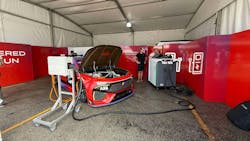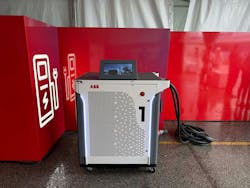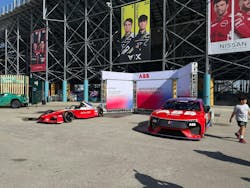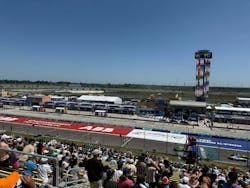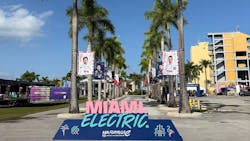How ABB and Formula E are Changing the Game for All EVs
In a groundbreaking event at the Miami Homestead Speedway, ABB unveiled a collaboration of technology, speed, and sustainability by showcasing two of its electric vehicle initiatives: the ABB FIA Formula E World Championship and the ABB NASCAR EV Prototype. But beyond the spectacle of high-speed racing, this event marked a new chapter in reshaping how consumers think about electrification, sustainability, and the future of energy.
As a longtime racing fan who's attended several events over the years, experiencing my first Formula E race was something entirely new. For one thing, I could actually hear my husband next to me while we watched — a rare occurrence at most races. But what really surprised me was how exciting it was. With electric powertrains, there are so many more variables at play. A driver could be leading the entire race, only to have a yellow or red flag come out just as they activate their “attack mode” or boost. Meanwhile, another driver — maybe all the way back in seventh — could have conserved their battery better or saved their boost, and suddenly they’re surging forward to take the lead in the final lap!
Sparking a Better Conversation
A Conversation Starter
“Here at the Miami Homestead Speedway in Florida, it’s a historic day for ABB, and I think it’s a historic day for our country,” said Chris Shigas, Vice President at ABB. “We are bringing together two very different electric race cars that are actually meeting each other for the first time. And we’re going to have a historic event using both the cars to really have a better conversation about energy.”
That “better conversation” is exactly what ABB is sparking — not just with industries or governments, but directly with the public. Through the lens of motorsport, ABB is demonstrating that electrification isn't just an abstract concept or a policy debate. It’s a tangible and practical transformation that’s already impacting how people move, live, and think.
“For the fans, it’s easy. These race cars are cool, right? They go fast,” said Shigas. “The NASCAR is 1,360 horsepower. That’s a massive amount of acceleration. So, I think as fans start to ask questions — how long does the car take to charge? How far does it go? What’s the zero-to-sixty speed? — they start asking all these questions and now we’re really learning about energy.”
The goal of the event is to translate racing technology and energy awareness into everyday knowledge. Regenerative braking, battery storage, and fast-charging systems are more than just race-day features — they’re technologies poised to become integral to consumer vehicles.
As NASCAR aims to decarbonize operations by 2035, events like this provide a glimpse into the possibilities. “They look at speedways like this... and they say, how can we create efficiency? How can we create sustainability? This is a massive infrastructure project,” said Shigas.
Technical Features & Charging Infrastructure
Technical Features and Engineering Adaptations
The ABB NASCAR EV Prototype features a 74 kWh battery and delivers up to 1,360 horsepower at peak output. The car is based on NASCAR’s Next Gen chassis with modifications for electric systems, including carbon fiber components to balance added battery weight. The vehicle uses a tri-motor, all-wheel-drive system, which allows for adaptable power distribution depending on track conditions.
The vehicle’s design is optimized for short tracks and road courses, where braking energy can be recovered to extend range (regenerative braking).
“Benefits of an electrical powertrain Is the fact that it's tunable. So, when you look at internal combustion engines, if you want to add more horsepower, there's things that you have to do internally to the engine: changing out parts, strengthening parts, things like that. With an electric power train, we have limitations in terms of top end limitations but anywhere in between we're able to adjust as needed,” said Tobin.
This level of control and customization has major implications for how consumers could interact with future electric vehicles — enabling smarter, more efficient performance tailored to individual needs and driving styles.
Charging Infrastructure and User Experience
For ABB, making electrification more approachable also means making it more intuitive. That’s why their charging infrastructure is built around ease of use and smart design, particularly in Formula E.
“We specifically designed a Formula-E charger ... we worked together with FIA and with Formula-E and all the race teams,” said Bas Berix, Project Manager at ABB. “They also don’t have to interact with the charger, so they can literally just take the cable, plug it in, and it automatically starts charging.”
This user-friendly approach includes visual cues — lights that change from white to green to blue to indicate connection and charge status — and smart charging methods designed to extend battery life and efficiency.
Berix said it’s a 160-kilowatt charger and can do 160 on one outlet or 2 x 80 kilowatts so two cars can be charged at the same time.
The official charge time is within 30 minutes, but teams follow a staged charging strategy for battery longevity. “They charge it to 50%, then... 70%, and then an hour before the race they charge to 100%,” Berix explained.
Energy recuperation and management are critical for race strategy in Formula E.
“During the race, they need to recuperate 40% of the energy to be able to finish the race,” Berix said. “So, for Formula E races it's really important to do energy management. So, during the race, the race lead cannot be the lead for the whole race because then they consume more energy and he will not be able to finish the race. So, you need to swap places to be able to use the air flow from the front runner to save energy.”
Overcoming Infrastructure Variability Challenges
Berix said with any temporary setup at a venue, there will be challenges regarding grid load but most challenges can be overcome.
“It really depends on the race, so I know in Berlin for example, we had a huge airfield, so there they were using solar energy. In Cape Town, we had to use biodiesel generators. So it really depends on the venue and they adjust. In Europe, since last season they have a nice solution with batteries — during the nights they use a small grid connection to charge the batteries and during the day we can empty the batteries into the cars. So it really depends on the venue. If they don't have the full power available, then we can reduce the chargers, we always find a solution,” he said.
From Track to Everyday Usage
By placing electric vehicles at the heart of the sports and entertainment world, ABB is helping to shift public perception of what electric vehicles are and what they can be.
“I think all of these lessons learned show that this is a moment in time in our country where... we’ll look back five years from now, we’ll look back ten years from now and say this was a historic moment,” Shigas said. “This is when we started to see change in the energy transition translate from concept in industry boardrooms to sports and then to the public and consumers.”
About the Author
Christina Marsh
Senior Editor
Christina Marsh is senior editor of T&D World at Endeavor Business Media (EBM), responsible for managing, editing, and contributing to the print issue production in addition to e-newsletters and digital content including podcasts. Previously, Christina was editor of Airport Business at EBM where she was responsible for contributing editorial support for the magazine, writing and compiling e-newsletters as well as contributing to digital content including producing video and podcasts. Before working with EBM, Christina was a multimedia journalist and podcast producer at The Experimental Aircraft Association (EAA). She graduated with a B.S. in journalism from the University of Wisconsin Oshkosh.
